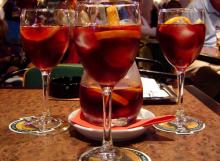This past summer, I took a small mini vacation for a few days in California. It was near dinner time and I went for a grocery run for a band that I was staying at in the recording studio. I drove a band member’s smart car to head down to the local Whole Foods market just about a few minutes away from the studio. I had a list of food items dialed onto my cell phone just in case I forgot something. It was about 7 p.m. in the evening, so traffic was actually not too bad. I was actually making dinner that night for some band members. They specifically wanted ravioli and bread for dinner. As I was going down the list of food items on my phone, I passed by the wine aisle. I do not drink wine, but happened to be glancing around. I noticed some Sangria alcoholic beverages lying nearby. It had a very interesting design to the bottle, so I decided to put a couple large Sangria bottles into my shopping cart. I was making my last stop for cold tea drinks at the store and headed out to the check out stand. As I drove my way back to the band’s studio, I was thinking about the bottles of Sangria I just purchased. Since I was staying in California for a few days, I wanted to have a good time. I decided I wanted to have some drinks tonight with the band mates over ravioli and Sangria.
Sangria is basically a famous wine punch from mainly Portugal usually consisting of fruity red-wine, sliced fruits, sweetener, cinnamon spices, sugar, a small amount of other alcohol such as brandy, triple sec, or liquor, and ice with added sparkling soda flavor. The alcoholic content of Sangria varies. White wine can be used in Sangria instead of red. For example, Chardonnay can work as a type of white wine to Sangria. Some people add a bit of sweetener to sangria such as cinnamon or sweet sugar. For a richer taste, people usually add a more intense wine flavor for a stronger taste. It is usually served with orange juice, sweet lemonade, and a slice of fruit choice for sweetness. Preparing small slices of fresh fruits and refrigerating them for a few hours can also be great to add to ice and served with Sangria cold. If you are allergic to certain alcohol content, there is also a non-alcohol version of Sangria consisting of wine grapes, carbonated water, lemon, and cane sugar.
Sangria is very popular in South America during the summer months of mainly Spain and Portugal. It is also very popular in many parts of the country. It is a great drink amongst tourists in pubs, clubs, and bars. Sangria is served as a punch, from a large pitcher bowl in the Spanish culture during social gatherings, parties, and events. A big wooden spoon or folk is often used to get the fruit out of the bottom of the pitcher. Many restaurants in parts of South America are commonly served with Sangria in restaurants. During the hot summer months, Sangria is great for a cold alcoholic beverage drink anywhere.
As I was cooking ravioli for dinner that evening, I decided to make some ice cold Sangria drinks for the band. Since the summer weather was a bit hot and humid in the evening, Sangria was a lovely edition to the delicious ravioli dinner. Drinking a glass of Sangria was very nice and lovely. Sangria will be added to my list of favorite alcoholic drinks.
